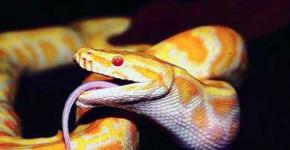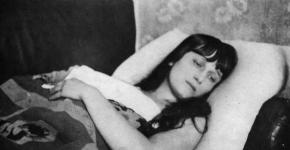Abstract of the lesson on familiarization with the outside world “Autumn changes in nature
State special (correctional) educational institution for students with disabilities, comprehensive school– boarding school VIII type with. Vannovsky Krasnodar Territory
Summary of the lesson on the development of speech
in 4th grade
“Seasonal changes in nature. Signs of autumn.
prepared
teacher primary school
Maslova Galina Alexandrovna
with. Vannovskoe
2011
Speech development
TOPIC: Seasonal changes in nature. Autumn signs.PURPOSE: 1. To teach to observe nature and draw conclusions about changes in inanimate and living nature with the advent of autumn; repeat signs autumn months, autumn. 2. Develop speech, memory, attention, observation, skill analyze. expand horizons; 3. Cultivate love and respect for nature, animals, birds.EQUIPMENT: Reproductions depicting autumn landscapes, a bouquet of autumn leaves, subject pictures depicting animals, birds; individual cards, leaf structure poster, presentation.During the classes.
I . Organizing time.
a) Submitting a report to class attendants.
b) Evaluation by the teacher of class preparation for the lesson.
II . Introductory conversation.
1. Working with paintings . slide 2-4
Consider the pictures, what season is depicted?
Name the autumn months.
List the signs of autumn.
(As a result of the discussion, the main changes in nature are highlighted.)slide 5
* Shorter daylight hours.
* The sun is below the horizon.
* Cooling.
* Frequent rains and fogs.
* Changes in the plant world.
* Changes in the animal kingdom.
2. Working with the weather calendar.
Tell me how the weather has changed in October compared to September.
Which days are more sunny or cloudy?
What can be the conclusion?
What is the weather today? (The attendant notes the weather on the calendar.)
3. Reading a poem by a teacher. slide 6
Even though it's getting colder, autumn is a wonderful time of the year.
In your tent, magical
And beautiful.
Autumn called us to the holiday,
She scattered her colors everywhere
And nature blossomed wonderfully!
4. Reading a poem learner.
Autumn at the edge
Quietly through the leaves
Conducted with a brush.
Yellowed hazel,
The maples turned red
In autumn purple
Only green oak.
Birds fly away
Don't miss the summer!
Look - the grove
Golden color!
III . Announcement of the topic of the lesson. Slide 7.
IV . Consolidation of the studied material.
1. Work on the story of N. Nadezhdina "The forest is taking an exam."
a) Selective reading.
Read what begins in the forest in autumn? (Holidays.)
What must forest dwellers do before autumn dismisses them for holidays?
(Must pass the exam.)
Read Who Passed the Exam First? ( Migratory birds.)
b) Solve riddles.
Comes to us with warmth
Make a long way.
Sculpts a house under the window
From grass and clay. (Martin.)slide 8.
I've been catching bugs all day
I eat insects, worms.
I don't fly in winter
I live under the ledge. (Sparrow.)slide 9.
(Pictures depicting a swallow, a sparrow are hung on the board.)
How are these birds different?
(Swallow - migratory, wintering sparrow.)
2) Work on the proverb. slide 10.
Explain the meaning of the proverb.
"September hurries birds on the road."
No matter how good the autumn weather is, no matter how full the September forest is, and some birds need to fly away - the path is long.
What is the reason for the autumn departure of birds in warmer climes?
(With a lack of food in cold, winter time.)
3. Guess the crossword. Slide 11.
| c | a | P | l | I | |||||
| d | I | t | e | l | |||||
| G | R | a | h | ||||||
| in | about | R | about | b | e | th | |||
| well | at | R | a | in | l | and | |||
| e | |||||||||
| l | a | with | t | about | h | to | a |
||
| f | and | l | and | n | |||||
| s | |||||||||
| with | to | in | about | R | e | c |
1. Stands on one leg,
He gazes into the water.
Looking for frogs in the river
A drop hung on the nose
You know it's-(heron).
2. He hollowed a tree for a long time
And exterminated all the insects.
Didn't waste time
Of course, this is(woodpecker).
3. All migratory birds are black.
Cleans arable land from worms.(Rook).
4. Little boy
In a gray coat,
Drifting around the yard
Collects crumbs.(Sparrow).
5. The brothers stood on stilts,
Looking for food along the way.
On the run, on the go -
They can't get off their stilts.(Cranes).
6. Guess what kind of bird:
dark small,
white from the belly,
The tail is forked, in two tails.(Martin).
7. During the day he sits like a blind man,
And only in the evening - for robbery.(Owl).
8. On a pole a palace,
Singer in the palace
And his name is -(starling).
4) Conversation;
Which of the following birds are migratory and which are wintering?
Tell me which birds stay wintering in Krasnodar Territory?
What should be done to make it easier for birds to overwinter?
Well done.slide 12.
4) The story of the teacher.
Orioles, swifts, swallows, nightingales are the first to leave our forests. Just before the onset of cold weather, geese, ducks, and cranes fly away.
Have you seen the birds fly? Tell us about your observations.
(Children's stories).
Cranes and geese fly in a "wedge" (angle).Slide 13-15.
The bird flying in front has the hardest time. She cuts through the air. adults, the strongest birds, always fly in front, and behind them - young and weak ones.
Phys. minute.
Crane, Crane!
He flew over a hundred lands.
Flew around, went around
Wings, legs worked hard.
6) Work on the story.
How do trees pass the exam? Read.
a) Selective reading.
(Leaf fall begins).slide 16.
b) The teacher's story. (Autumn leaves lie on the tables of children).
In autumn, the leaves begin to turn yellow. Yellow paint is always in the leaves. Only in summer yellow invisible. It is drowned out by a stronger one - green.
Autumn is coming, the nights are getting longer, the plants are getting less light. The green color in the leaf decreases, and the yellow color becomes more noticeable. But leaves are different color. It depends on what coloring matter is in the withering leaf.
Take autumn leaves in your hands, tell a poem and make a bouquet.
7) Reading a poem uch-Xia.
Golden leaves fall, fly.
Golden leaves cover the garden.
There are many golden leaves on the paths,
We will collect a good bouquet from them.
We'll put the bouquet in the middle of the table,
Golden autumn has come to visit us.
8) Conversation.
What is leaf fall for?
(Answers of children).
Conclusion: Slad 16.
*Protect the tree from winter drought.
* Ridding the tree of toxic substances.
*Protection of thin and fragile branches from the severity of snow falling in winter.
9) Practical work.
How are the leaves different?
(Shape, size, color).
What does it depend on?
(Which tree is the leaf from?)
Is there anything in common in each sheet?
(Leaf plate, veins, petiole.)
10. Independent work.
a) Children draw the structure of the sheet on the landscape sheet.
b) A poster appears on the screen: “Leaf structure”.slide17
Phys. minute.
The sun is paler
The sky is colder.
If you go out in the evening
The jackdaws freeze in the wind.
The shadow lies long
The leaf falls for a long time.
11. Selective reading.
Who else is taking the exam in the fall? (Beasts).
Autumn is a busy time for animals, they are preparing to spend the winter.
And here is the squirrel, and the bunny,slide 18.
prickly hedgehog, brown bear.
Now we will ask them to say
How do they celebrate autumn?
12. Dramatization: "Autumn meeting in the forest."
Hare: It's time for me to bunny, molt,
It's time for me to change my coat.
I can't be gray in winter
I will be seen in the snow.
Squirrel. And I'm in a hurry, I'm in a hurry
I dry mushrooms on knots.
I stock up for the winter
I'm very cold right now.
Bear. I will soon go to bed in the lair,
After autumn - winter again.
Let me in my dream
Dream of honey.
Wake up when it's spring
Will come.
Hedgehog. I am going to sleep too,
Like a bear.
I hunted for the summer
Looked for mushrooms, caught mice,
I need to rest for this.
I'm tired, exhausted.
I'll bring myself knots,
I will make an apartment in the forest.
Teacher : Well, try
At a good hour.
In the spring, we will be glad to see you again.
13. Repeating the rules of human behavior in the forest.
Do you know the rules of human behavior in the forest?
(Children's stories).
V . Repetition. slide 19.
a) Reading the rules.
* Take care of plants and animals.
* Do not burn grass in autumn, as it can set fire to the forest.
* Do not cut or break trees and shrubs.
* Do not leave cans, bottles in the forest. Take it with you and throw it away in a specially equipped place.
*Do not destroy nests and anthills.
* Do not make noise and do not disturb the inhabitants of the forest.
b) Work on a crossword puzzle
Each season has its own favorite color, what color of autumn, we will find out by solving a crossword puzzle.
1. As called. birds that stay over the winter? (Winterers.)slide 20.
2. A natural phenomenon, more often in autumn. In summer it is called warm, mushroom, in autumn - cold, drizzling. (Rain.)
3. The phenomenon occurs only in autumn. Trees dress up in beautiful dresses and then shed their leaves. (Leaf fall.)
4. If the night is colder than the day, water droplets form on the grass, what is it? (Dew.)
5. This natural phenomenon looks like a light haze in the air, and sometimes like a white transparent wall. What is it? (Fog.)
6. The time of the year following the fall. (Winter.)
7. In autumn, birds fly away to warmer climes. They gather in large groups.
What is the name of such a group? (Flock.)
| h | and | m | at | Yu | sch | and | e | |||
| d | about | well | d | b | ||||||
| l | and | with | t | about | P | a | d |
|||
| R | about | with | a | |||||||
| t | at | m | a | n |
||||||
| h | and | m | a | |||||||
| with | t | a | I | |||||||
VI . Outcome. Slide 21-22.
Evaluation of children's work. Presentation of autumn leaves with evaluation.
The forest is taking the exam.
Holidays begin in the forest in autumn. The seeds of the plants have ripened, the birds and animals have raised their young, and you can rest.
But before autumn dismisses the forest dwellers for the holidays, they must pass an exam. All without exception: both small grass and a big tree and bird and beast.
It will be cold to ask at exams, and with all severity. Everyone is asked only one question - the question of life. Whoever fails the exam will not live until next spring. Migratory birds were the first to pass the exam, back in the summer. They needed to molt, change the feathers on the wings: after all, flying would take a long time.
You are walking through the autumn forest with autumn leaves swirling over your head. Fall at your feet.
Yellow leaves are a signal of drought. The roots take water from the ground and supply it to the tree, the leaves use it up and evaporate it. If the flow of water is greater than the income, in order not to die from drought, the tree must part with the foliage.
But three days ago it was raining, and yesterday it was drizzling. Can there really be a drought in September? Does the tree need water? There is a lot of water, but a tree cannot take it. The earth turned cold in autumn, and cold water do not absorb root hairs. It's time for the trees to take their exam. The leaf fall has begun.
Pick up a yellow leaf from the ground, try with your finger how thick and rough the petiole has become.
A tree loses thousands of leaves in autumn, but there is not a single wound on the tree from which juice would ooze.
The leaves will fly around, but the buds will remain on the branches. They will turn green next spring.
Preparing for exams and animals. A bear is like a bear: in order to get to the rowan berries, he bends and breaks a whole tree. The bear goes to feed and in the field until the oats are harvested there. For a bear, a hedgehog, a badger, passing an exam is fattening up. Animals do not have to rely on food in winter. Only fat will keep them alive. It is necessary to accumulate more fat: the skinny one will not last until spring.
The less the animal moves, the less fat it will consume. The bear falls on the side. The bear, the hedgehog and the badger will oversleep their holidays.
No wonder the badger arranges a featherbed made of dry leaves in his hole. Half a year to lie on a hard one - the sides will hurt.
N. Nadezhdina
List of used literature.
Khudenko E. D., Terekhova I. A. Acquaintance with the outside world. Textbook for special (correctional) schoolsVIIIkind. 4th grade. Moscow 2004
Aksenova A. K., Yakubovskaya E. V. Didactic games in Russian language lessons in grades 1-4 of an auxiliary school.
Kostina E. P., Morozova S. A., Azaryan D. A. The development of speech of primary school students. Teaching aid. Krasnodar 2001
Yudina I. G. Natural history. Non-standard lessons and creative tasks. 1-4 grade. Volgograd 2002
Department of Education and Science
administration of the Gubkinsky urban district
municipal budgetary educational institution
"Secondary school No. 7"
Methodical development of a training session.
Gubkin - 2013
Seasonal changes in nature. Autumn.
Explanatory note.
Methodological development is a cycle of three lessons under the same name: "Seasonal changes in nature." Tours are held at different times of the year - autumn, winter and spring. The first tour of this cycle is held in autumn. Of course, it is difficult to disagree with the fact that it is best to understand and imagine how nature changes only in the process of personal observations. It is very important to show and tell children that autumn is a long period of time when nature is preparing for winter. After all, autumn is the period of preparation for the cold, lack of food, winter precipitation in the form of snow. Different animals behave differently at this time. The tour should be held in the nearest park, square. Children are often there. Many of them know what kind of trees grow there. In the process of work, they can be active assistants for the teacher. It is important that after the excursion the children understand that everything in nature is natural. The leaves change color because there is not enough sunlight. They fall off so that in winter the branches do not break under the weight of snow. Migratory birds leave our lands, as they will not be able to feed themselves in winter and will freeze, unable to withstand low temperatures. That all animals adapt to life according to their own rules and laws.
Purpose of the tour : observation of autumn changes in animate and inanimate nature.
Tasks:
- observe the autumn changes in wildlife;
- to introduce children to coniferous and deciduous trees, the peculiarity of their preparation for winter, to learn to recognize the leaves of the most common tree species;
- to cultivate a sense of beauty, the ability to admire the beauty of the surrounding world, respect for nature.
Methods used:
- verbal: the story of the teacher, the guide and the statements of the students, a short conversation;
- observation;
- practical: drawing up herbariums from autumn leaves.
Age of students: 7-8 years old.
Equipment and decoration:
- herbarium folders;
- empty carton boxes for dry leaves;
- two red flags to accompany the column of children when crossing the roadway.
Methodological advice for the preparatory period:
Preparing the teacher for the excursion.
Before organizing a tour, the teacher must choose for her appropriate place. It is advisable to choose a plot of the park, square with deciduous and coniferous trees. Having visited the place of the excursion, the teacher outlines objects for observation, places of stops.
You need to first divide the children into three groups. One consultant should be assigned to each group. Consultants are given a package containing a folder for herbariums.
Preparing students for field trips.
In previous lessons, children repeat the rules of behavior in the forest, park, square. Immediately before the tour, the teacher reminds the children about the rules for crossing the roadway.
Tour plan:
- Introductory conversation.
- Introduction to deciduous trees.
- Collection of autumn leaves for herbariums.
- Acquaintance with coniferous trees.
- Birdwatching.
- Talk about park animals.
- Summing up the tour.
1. Introductory conversation.
(It is carried out directly at the place of the excursion.)
Teacher: Guys, what time of year is it?(Autumn.)
Pay attention to the sky. What is it?(Children's answers.)
How warm is the sun?(Children's answers.)
How has the length of the day changed? ( children's answers.)
Guys, you already guessed where we are. Guess the riddle:
The guys have a green friend,
Cheerful friend, good,
He will stretch out hundreds of hands to us
And thousands of hands.
- Have you guessed which green friend the riddle is talking about?(Forest, park.)
What hands are we talking about here?(Leaves.)
Has it changed appearance leaves compared to summer?(Children's answers.)
2. Acquaintance with deciduous trees.
Teacher: I suggest you collect different leaves under the trees.
(Children collect leaves, the teacher reminds that the leaves must be collected, and not torn from the trees, so as not to accidentally break the branch and injure the tree).
Teacher: Trees that have leaves on their branches are called deciduous.
What kind deciduous trees are you familiar with?(Poplar, birch, maple, linden, chestnut, pear, apple, mountain ash.)
- Tell me, how are your leaves different from each other?(Size, color, shape.)
(Children look at the leaves)
Teacher: Can you tell which tree these leaves are from?(Yes, you can.)
This leaflet has one leaf blade and one cutting.(The teacher shows a leaf of maple, linden.)Such leaves are called simple.
This leaflet has several leaf blades and one cutting.(The teacher shows a leaf of chestnut, mountain ash.)Such leaves are called compound.
What happens to leaves in autumn?(They fall off.)
Do you guys know why trees shed their leaves in autumn?(Children's answers.)
In winter, precipitation often falls in the form of snow. If there are a lot of leaves on the trees, the snow will stick to them, the branches under the weight of the snow will bend to the ground, they may break, the tree will die. So nature took care of the trees.
3. Collection of autumn leaves for herbariums.
- I suggest that everyone disperse into groups and arrange the leaves in herbarium folders relative to the type of tree. First, choose well-known leaves.
(At the end of the work, the children take turns calling the trees to which the selected leaves belong.)
4. Acquaintance with coniferous trees.
Teacher: Winter and summer in one color.
What tree are you talking about?(Spruce.)
- Small needles on the branches are needles. That is why trees are called conifers. Coniferous trees also drop needles, but not all at once, but little by little all year round. And the needles also grow all year round.
What other coniferous trees do you know?(Pine.)
(The teacher shows a sprig of pine and spruce).
- See how they are similar and how they differ.(The needles of a pine are longer, those of a spruce are shorter. In a pine, the needles cling to a branch in two, and in spruce, one at a time.)
- And the branches coniferous trees flexible, easily bend to the ground under the weight of snow, do not break. And there are always a lot of bumps on the top of the head.
5. Birdwatching.
Teacher: Look at the flock of sparrows. It's getting chilly. Not so funny little birds. And soon winter. Snow will cover the ground with a dense blanket. What will the birds eat?(Children's answers.)
And what will happen to those birds that feed on insects, foliage, grass?
(They flew to warmer climes.)
What birds stay for the winter? ( children's answers.)
- And so that the birds do not live in poverty in winter, let's make feeders for them.
6. Talk about the animals of the park.
What animals do you think are found in our park?(Mice, hedgehogs.)
How will they welcome winter?(Mice will prepare grain and seeds from plants in pantries, will winter in a warm mink, occasionally going for a walk. Hedgehogs will drag grass, roll in dry leaves and lie down to sleep for the whole winter in a hole.)
7. Summing up the tour.
What new did you learn in today's lesson?
What did you like the most?
And now I propose to collect bouquets of autumn leaves for mothers. The tour is over.
Methodological advice to the organizers:
The place for organizing the excursion is the nearest park, square. It is advisable to choose a place where a lot grows different trees. You can show children such trees as linden, maple, chestnut, poplar, pear, apple, mountain ash.
Show leaves, tree trunks.
Put the leaves of the indicated trees into herbarium folders as samples.
Methodological advice for the period of the next aftereffect:
In subsequent classes, children draw up herbariums. You can offer participation in the competition of drawings "Golden Autumn". Children make bird feeders and hang them in the station yard, kindergarten, schools.
Bibliography
- Nuzhdina T.D. Encyclopedia for kids: Miracle is everywhere. World of people. / Yaroslavl: Academy, K; Academy Holding, 2000.
- Pleshakov A.A. The world around us: Method. Benefit: 1 class. / A.A. Pleshakov, V.P. Aleksandrova, S.A. Borisov. - M .: Education, 2002.
- Fefilova E.P., Potorochina E.A. Lesson developments at the rate The world. / "VAKO" - Moscow 2006.
Prepared by: Gapchenko Svetlana Nikolaevna, social teacher
municipal budgetary educational institution"Secondary School No. 7" of the city of Gubkin, Belgorod Region.
Integrated lesson of the surrounding world and technology
for 4th grade students with Ch. y. about. under the program of correctional schoolsVIIIkind.
Subject:“Seasonal changes in nature. Autumn".
Target: generalize and systematize children's ideas about characteristics autumn.
Tasks: a) educational: organize the activities of students in the perception, comprehension and memorization of knowledge about seasonal changes in nature in autumn; to form an idea of how nature prepares for winter; make an application "Leaf fall in the autumn forest."
b) developing: develop the ability to observe, compare, analyze, generalize; develop cognitive interest in the world around; develop fine motor skills.
c) educators: respect for nature
Equipment:
- presentation on the theme "Autumn";
- colored paper, scissors, glue;
- textbook E.D. Khudenko, I.A. Terekhov "Introduction to the outside world".
During the classes.
- Organizing time.
- Introduction to the topic.
The field is empty, it's raining.
The wind rips off the leaves.
Fog is creeping in from the north
Terrible clouds hung.
The birds are moving south
Slightly touching the pines with a wing.
Guess, dear friend
What time of year? (Autumn)
How did you guess that the poem is about autumn? (children's answers)
If they find it difficult: empty in the field, the wind rips the leaves from the trees, the birds fly south, the rain pours, when does it happen? (autumn).
Who guessed what the topic of the lesson is? (AUTUMN).
- Work on the topic of the lesson.
That's right guys. Theme of the lesson: "Autumn". In the lesson, we learn to answer with a full answer, to correctly compose sentences, clearly pronouncing the sounds in words.
Look at the hint picture. Let's remember together what happens in autumn in nature? And we will tell you what signs of autumn we know.
Encourage children to answer in full. (The days are getting shorter, the leaves are turning yellow, the river is cold, it's harvest time, the birds are flying away, the animals are hibernating, it's getting colder, it often rains cold).
Well done, you know the signs of autumn.
Remember and name the autumn months. (children's answers)
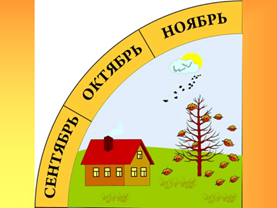
Autumn is very beautiful to watch the trees, for how the foliage changes its color.
- Fizminutka.
Yellow leaves fly, fall, spin,
And under your feet just like a carpet lay down!
What is yellow snow? It's just ....... (leaf fall).
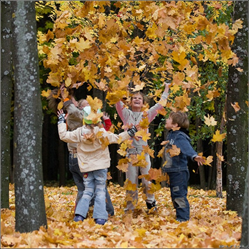
What is the time called when the leaves fall and fall under our feet? (Leaf fall).
v. Working with the textbook.
Task number 1.
Find a picture that shows golden autumn».
Why did you choose this picture?
What emotions does this fall evoke in you?
Describe leaf fall using 10 action words.
VI. Practical work.
Today in the lesson we will complete the application "Leaf fall in the autumn forest"
You have colored paper and cardboard on your table.
What color are the leaves in autumn? (Reviewing pictures with autumn nature)
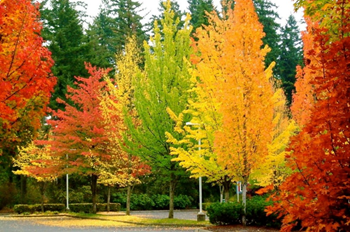
Choose paper colors that work for the leaves.
First we have to cut tree trunks for our forest. (The outline of the trees is already drawn on brown paper)
Carefully work with scissors. (we can help cut if necessary)
Tree trunks are ready. Now we will do the fall.
Leaves can be done in two ways: 1. If the children are good with scissors, cut small pieces of paper different colors
1. If children do not know how to use scissors, we tear the paper into small pieces.
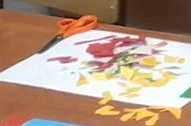
The trees are ready, the leaves too, now we glue the tables on the cardboard background of the application. And glue the leaves.
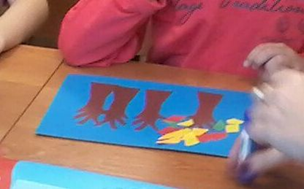

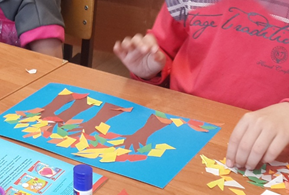
Our "Leaf fall in the forest" is ready! Look how beautiful your work is!
VII. Anchoring.
- What time of year is it in your forest?
Ball game.
- I throw the ball and ask a question, and you answer and throw the ball back.
Questions:
What color is the sky in autumn?
What is the weather like in autumn?
What is the sun in autumn?
What is the air like in autumn?
What mood does autumn evoke?
Name autumn month.
VIII. Reflection.
What did you learn in the lesson?
Who likes to make an application?
Who was in a good mood today at the lesson?
Nina Dyrnaeva
Synopsis of the game-excursion “Seasonal changes in nature. Looking for autumn
Synopsis of the excursion - games on the topic
« Seasonal changes in nature. Looking for autumn».
Goals: To acquaint children with the phenomena of living and inanimate nature inherent autumn to learn to discover relationships between phenomena nature.
Develop observation and analysis skills.
Cultivate love for nature understanding of her beauty, caring attitude towards her.
The development of children's speech.
Vocabulary: maple rowan lionfish all-terrain vehicle
Equipment: rope, signs, picture.
During the classes:
1. Organizational moment.
2. Introductory conversation.
Guys, what time of year is it?
-Autumn.
Where is she? Have you seen her?
No, it's still warm...
But autumn has come. What month is it?
September.
This is autumn month?
But autumn has come. Where is she? Maybe she's hiding? Let's go find where you hid autumn.
We will search by image « Autumn» . Do you know the signs autumn? Let's paint her portrait together.
The teacher shows pictures of a birch. She still has a green crown, in which several yellow leaves.
What are the signs autumn on the birch.
Yellow leaves.
Right! So let's go look for this sign autumn.
The teacher offers the children "to go" on an all-terrain vehicle called "Yellow Leaf".
Where can we get an all-terrain vehicle?
Yes, here he is!
The teacher takes out a soft rope, the size of which corresponds to the number of children in the class, standing one behind the other. Children take the rope in their hands on the right and left.
The vehicle is ready to move!
The movement of children is organized along the route chosen by the teacher. This is a forest.
3. The first stop is at the birch.
Admire the birch, look at it carefully and try to find signs of autumn. Who remembers what the main sign autumn?
Yellow leaves.
Well done! Solve the riddle autumn. Found where she was hiding. Think again and say what color autumn?
-Autumn is yellow...
And now look for another sign of autumn. Let's search on the ground. Look what is it?
These are fallen leaves.
What leaves lie under the birch?
Correctly.
The teacher suggests comparing two birches by the number of yellow leaves on the crown. Next, it is proposed to collect fallen leaves for the manufacture of applications.
4. The second stop is at the mountain ash and at the maple.
What color are rowan leaves?
Red.
Pay attention to what rowan fruits have.
What color are maple leaves?
And what are the fruits?
That's right, maple fruits are lionfish. Compare maple and rowan leaves. They are the same?
No, they are different.
Maple and rowan leaves differ in color and shape. Collect leaves for application.
We got into fairyland named Les. These trees are familiar to you from childhood. Together with them we find ourselves in a fairy tale. It is believed in the forest that Baba Yaga, Leshy and others live here fairy-tale heroes. But some bad people cut down trees, break them. Can you do it?
And who knows how to behave in the forest?
Children talk about the rules of behavior in the forest.
The forest is our wealth. It must be protected from bad people, from fire. We come to the forest to relax, pick mushrooms and berries. And may it always remain as green, beautiful, clean as it is now.
The excursion is summed up.
What interesting things did you see in the forest today?
Children talk about their experiences.
The tour ends, the children go to the shelter with the teacher.

